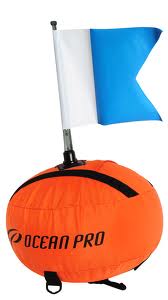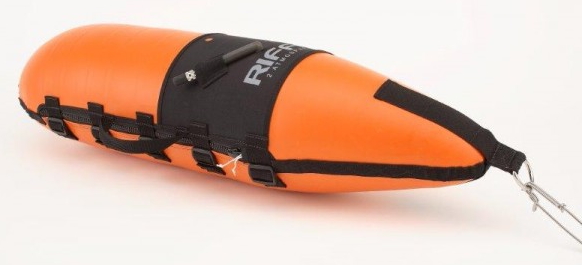Introduction
Floats are an essential part of spearfishing, there are different types and different uses. I will use the words Buoy and Float interchangeably throughout this post. Below I will talk about the main types in no particular order.Base/normal Buoy (with or without flag)
Flags
There are two types of flags:- North American "Diver down flag": This flag is red with a white stripe from the upper left corner to the lower right corner.
- International "Diver down flag" (aka "Alpha Dive Flag"): This flag represents the code signal A International maritime signal, it is white and blue.
Shapes
There are many different types/shapes to choose from. The classic shapes are the spherical:which is good for staying in one area, it fairs well to choppy seas and usually has a high flag which allows you to be seen from farther away. Then there is the torpedo:
Which is better for towing around due to its streamlined shape, the flag is usually not high fine they can flip over easily which is why I don't like these with flags (they are fin without). Since you need a flag in many parts this is why I don't use this shape. A variant of this is the bullet:
These excel in kelp forests, they don't get tangled up as much due to their shape.
Then you have the boogie board type:
 |
| Banks board, the best in its class |
 |
| A homemade one, the most affordable |
The next type is the flat inflatable type:
 |
| Unfortunately Best Hunter no longer makes this one |
Next we have the boat type:
This is a cross between the flat inflatable and the boogie board types. It is inflatable and allows you to carry quite a lot of stuff with you and does not flip over easily. Being inflatable it is airplane friendly. Like the boogie board type it has a lot of drag, more than a boogie board, that is the price to pay.
Surface Marker Buoy (SMB, aka Safety Sausages)
This type of buoy is a long skinny cylinder. It is used by spearfisherman to mark the diver's location generally when he/she is out of the water. It is a good thing to have with you in case you have to signal boats by waving it around. It is also used to mark a location underwater, for example a small cave entrance/big rock where you spotted a big fish inside/under or to mark the location of a shot fish in kelp forests. For this last use-case it is not needed to fully inflate it, but please be aware that there are dangers of using precious O₂ underwater to inflate a buoy, you could black out easier when returning due to the lack of oxygen. These are inflated orally while in the water on a single need basis and is attached somewhere in case it is used to mark underwater locations. One variant is the Delayed Surface Marker Buoy (DSMB). It has a CO₂ inflation mechanism to allow inflation underwater without sacrificing your lung's air supplies. It can therefore be used to bring you or other small items up quickly (provided you have the correct amount of CO₂) or to help pull fish out of under rocks/caves/kelp. Some good DSMBs are the Carter Float, the Riffe Utility Float and the Ultimate Utility Float.Blue Water Floats
Attaching floats
You usually attach floats using either a braided floating line or a tubed float line. if Blue water hunting you can add a bungee line in between the float and the floatline. As the name explains, a floatline floats :-); the reason for buoyancy is that when you dive the line stays vertical and doesn' t snag on everything.- Braided floatlines: they are cheap and they do the job. They are braided nylon usually and are not as buoyant as tubed floatlines though and thus can snag on stuff more. On the positive side they are light and not bulky thus won't weigh down and take up space in luggage.
- Tubes floatlines: this is a spectra (or nylon for the cheap ones) line that runs in a soft watertight tube. They are quite expensive because of the materials used and the more complex manufacturing involved. They float well but are bulky and heavy.
- a speargun handle:
- a breakaway system:
- a small (500g-750g) grapnel anchor:
My Buoys
As you know I have to travel often by plane to spearfish so I have to take this into consideration when buying buoys. I don't want to have to carry a pump or have to go find one somewhere (I know service stations have them but I don't want to have to find one). I chose to buy:- Pocket Buoy: this float folds up small and is really great especially when traveling light, it even has a lifetime warranty. It uses balloons to inflate, the bigger type (43cm/17"), which are relatively easy to find and light to carry; for the counter weight you can put rocks in the bag and clip use that. I am very happy with it, I initially got the first version that had design flaws (the flag pole came apart with waves but it since got fixed and they sent me replacements for free.
- Carter Spearfishing Float: I wanted a DSMB so that I could signal my location in case I get carried away by current, also I want to mark interesting spots (with fish!) under water and in emergency cases get pulled up to the surface fast. I purchased the dual inflator model and also the Riffe Utility Float Holder so that I can put it on my weight belt. To mark the spot under water, I hook up a bike CO₂ inflator regulator to the oral inflation valve and partially inflate it, keeping the two CO₂ inflators for emergencies or to pull up stubborn fish stuck in holes.
- Best Hunter Okipa 2: I love this float! It is a bit pricey, heavy and cumbersome, even when deflated, but it is so nice to have. It is like a little boat or an inflatable buggy board, you can put two spearguns on it, water, food, etc, and use it to rest. It is still airline friendly and provides you with a base buoy including the flag. It is a bit bulky to lug around in the water, so I tend to use it anchored, sort of like "base camp" and use the pocket buoy if I want to travel a bit further (not too far to keep an eye on it though). Click here to read my review.
If yo have any remarks or if I made any mistakes, please don't hesitate to comment below!



















No comments:
Post a Comment